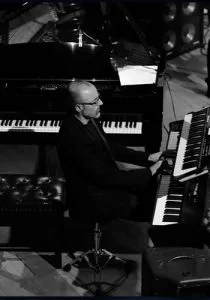General, Piano Technique, Tutorials
 The “Holy Grail” for pianists is to find an “effortless” technique which allows them to be at one with the instrument. This is something that has interested me for the past 20 years and which I believe I’m beginning to gain some understanding of. I’ve been meaning to blog about this for ages but it’s such a huge subject!
The “Holy Grail” for pianists is to find an “effortless” technique which allows them to be at one with the instrument. This is something that has interested me for the past 20 years and which I believe I’m beginning to gain some understanding of. I’ve been meaning to blog about this for ages but it’s such a huge subject!
Most of what’s written below is taken from an email I sent to a colleague regarding piano students and how this may be of benefit to some of the more advanced pianists.
The whole subject of technique is extremely complicated and is not simply understanding the mechanism by which we play the instrument, but relies hugely on how we hear and think about music too.
For me, there is a distinct difference between “technique” and something which I shall call “mechanism”. By “mechanism” I mean an efficient use of the muscles of the hand and arm which allows for “effortless” playing by means of gaining maximum effect with minimum input of energy.
Of course this is “technique”, but that word has other implications such as ability to play thirds, octave passages and other specific technical difficulties which are a different concern. Jazz musicians don’t need to build a formidable “technique” in the same way that a classical musician does but the ability to play accurately with precise rhythm and good tone, without conscious awareness of technique is vital. Although applicable to any good musician, this is a specific area of concern for improvisers because we cannot fall back on knowing the notes .
Any physical discomfort is a barrier to improvisation as we need almost all of our conscious mind devoted to creating the notes in the first place. We also need to learn how to combat unwanted tension.
I once asked a very well respected teacher what one should do if experiencing tension and the reply was “play through it!” which is a familiar response and one I find at best unhelpful and can in extreme cases lead to focal dystonia. Another problem which arises more often with students of Jazz/ improvisation is that they usually come to the piano at a later age and haven’t built up a technique at a time when their hands and wrists are more supple and still growing. As a result, many students play the piano with tension or at the very least a highly inefficient technique which wastes energy and produces a bad tone, usually with muscle stiffness. My own approach is based upon:
Firstly “timing” the key correctly – nothing to do with rhythm, but rather, feeling the point at which the hammer strikes the string so that one can input the minimum required energy to gain the maximum affect.
Maximising the use of the small muscles of the hand (which are very weak but allow great independence) while minimising the work done by the long flexors and extensors which are joined to the forearm. This system of muscles and tendons is very strong and yet impedes finger independence, results in a stiffened wrist, finger insensitivity and can result in pain if overworked. Most students I see (and many professionals) overuse these long flexors and extensors.
For me, the basic piano playing mechanism relies on:
allowing the hand to drop completely -thus allowing a loose wrist and removing unnecessary work from the Flexor Digitorium System in the arm.
For the finger to strike the key (“timing” the key/ hammer precisely)
The finger then supports the weight of the hand (rather like a house resting on stilts).
The fingers do not press at all- they support (they are never passive).
The next key is struck by a finger and the weight of the hand is transferred from the first finger to the next with no break – producing an “effortless” legato.
Additional energy required for most playing can be added by pushing from the arm or adding additional weight from the arm.
The “feeling” of playing a legato phrase is to drop onto the first note, then feel a continuous connection with the keyboard throughout the phrase and finally pick the hand up at the end. Playing is effortless, with a good tone and extremely rapid.Although this sounds simple, most pianists are unable to achieve the correct results due to an overuse of the long flexors. These give the pianist a feeling of strength and security but they also “take over” work that needs to be done by the small, far weaker muscles within the hand. This means that the pianist may look as though he or she is performing the correct action but the work is done by the wrong muscle groups and the correct feeling will not be achieved. Work must e built up from a very small sound, learning to time the hammer precisely and to allow the arm to completely let go of the hand at the wrist. Only then can additional power be added. Obviously this is only part of a comprehensive technique but the “mechanism” is essential. This is a huge subject and one which produces much disagreement among pianists! This is a really an introduction and I’ll be adding to this subject with images and video. I’d love to hear the thoughts of other pianists.
